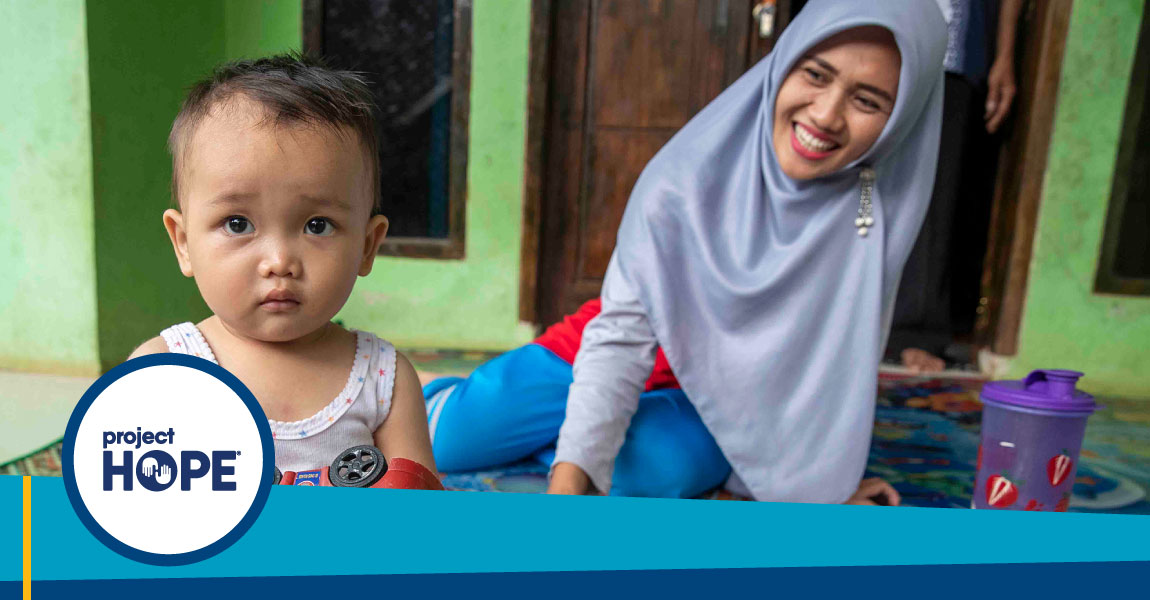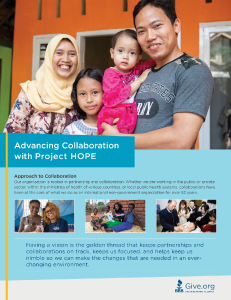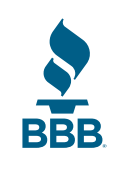
Advancing Collaboration with Project HOPE
About the Organization
For more than 60 years, Project HOPE has transformed the health and well-being of people and communities around the world. They work on the front lines of the world’s health challenges, partnering hand-in-hand with communities, health care workers, and public health systems to ensure sustainable change.
Featured Guest
Cinira Baldi
Vice president, Chief Development &
Communications Officer
Project HOPE
Approach to Collaboration
Our organization is rooted in partnership and collaboration. Whether we are working in the public or private sector, within the ministries of health of various countries, or local public health systems, collaborations have been at the core of what we do as an international non-government organization for over 62 years.
Build Trust
Trust is the basis for any strong collaboration. As an organization, we value transparency, good governance, solid financial management, reporting, and honest communication. We strive to build trust every day, and it begins with transparency about who we are, what we do, and our impact in the countries and places that we serve.
Have a Vision
Since everything is changing in our world, we make sure we have a long-term strategic vision and an immediate short-term strategy. As a part of our strong vision, we identify who we'd like to work with, our joint interests, the joint mission, and brand alignments. We look at our long-range planning and impact from a macro level down to a geographic and program level.
Having a vision is the golden thread that keeps partnerships and collaborations on track, keeps us focused, and helps keep us nimble so we can make the changes that are needed in an ever-changing environment.
Seek to Assure the Success of Your Collaborators
We believe in the importance of setting expectations to discover joint alignment and the potential for long-term collaboration. We have several longstanding partnerships with companies – on the corporate side, we collaborate with Ferring Pharmaceuticals in Sierra Leone. A large portion of their work is philanthropic and is focused on mothers and new babies. Our relationship thrives because we have that joint alignment, and we're both looking to grow together.
Take Stock
Taking stock is one of the first things we do before embarking on or engaging in a collaboration. Much of the initial conversation focuses on finding that joint alignment and presenting what we bring to the partnership. The first step includes a willingness to be vulnerable throughout the tough conversations, which goes back to building trust and being transparent about our strengths, weaknesses, and identifying bandwidth constraints.
Start Small
To us, starting small is about being nimble and being able to pivot quickly. When we're trying out a partnership or a program, we emphasize the importance of steady communication.We find that we can manage feedback loops as we're building trust throughout the partnership process. We're always looking to grow our collaborations. Our model heavily revolves around domestic and international partnerships because we strongly believe that no organization can do things alone. From emergency response to our core mission programs such as maternal or neonatal health, we're always looking to grow our collaborations because they're at the core of everything we do.
Take a Portfolio Approach
Taking a portfolio management approach is critical because so much of it goes into building the necessary trust. Much of the process requires reporting back to our partnerships and ensuring those reports include good impact and results. Having a portfolio allows us to make tough decisions about which partnerships we mutually want to grow or which ones don't align with our values.
Due to COVID-19, we've experienced an influx of about 40 new partners. We're currently trying to figure out which ones we can sustain outside of COVID, but we're very excited about a partnership with the Major League Baseball Players Association. The foundation's leader is phenomenal; they're very philanthropic and concerned with international and domestic issues as well. We're hopeful it will become a long-term partnership.
Consider Non-traditional Partners
In general, the nonprofit sector hasn't linked into collaborations as much as private, public, and corporate sectors. There's an opportunity for nonprofits to engage together — to team up and do more, especially now. In light of mental health, education, health disparities, and other factors that will impact our country in the next five years, we believe nonprofits should come together and confront the significant issues to plan what we can do for the next 5 to 10 years.
Keep Your Donors Apprised of Your Collaborations
Within our portfolio, we have funders we can rely on whenever there are emergencies or disasters. Say we're responding to explosions in Beirut — we can pick up the phone and ask if they're able to release any funding. They have a direct line to our head of programs, and the consistent communication results in additional rounds of funding.
Future Collaborations
We hope to work with the Gates Foundation. We see many potential opportunities in global health and innovation. We've developed apps in different countries that enable people to communicate with health workers because they don't want to go into the local public health clinic. We believe there are more opportunities to build out more technology-based health service providing capabilities.
We're also waiting on timing and bandwidth to expand our footprint throughout Europe's private and public sectors.
This article was composed by Rachel Romana Liu.




